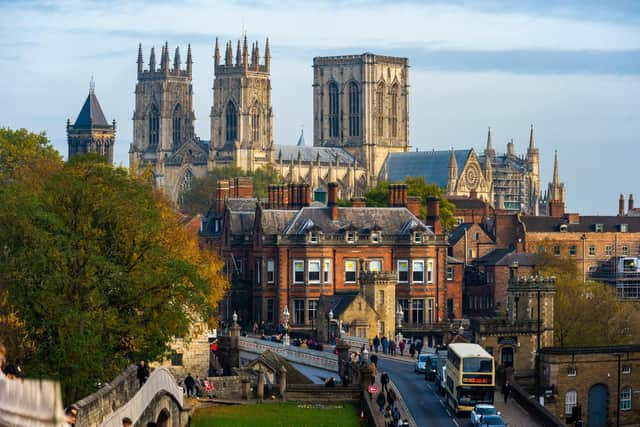Stories of triumph and tragedy behind world's greatest cathedrals including York Minster captured in new book by Yorkshire historian
Each one of the world’s greatest cathedrals is a feat of ecclesiastical architecture, greeted with awe and admiration from almost all of those who pass through the doors.
Embedded in the walls are intricate displays of craftsmanship and engineering, plain to see. But less visible are the human stories the cathedrals embody within their fabric, tales from the epicentre of life as it once was. These are stories of both triumph and tragedy, of the chaotic atmosphere of the mason’s yard right through to the cloisters of power.
Advertisement
Hide AdAdvertisement
Hide AdAnd it is these which historian, author and broadcaster Dr Emma Wells seeks to tell in her new book Heaven on Earth: The Lives and Legacies of the World’s Greatest Cathedrals. “There wasn’t something that really pinpointed the widespread nature of cathedrals across Europe and beyond but that also explored who are the people behind these buildings?” Wells says.


“And how does that link to the wider history of how we became medieval England and then modern England and Europe? I wanted to tell the stories of the people behind the cathedrals, their lives and their legacies, as well as the more interesting parts of the buildings, the bodge jobs and mistakes we don’t always hear of.”
The book is a culmination of years of fascination with cathedrals for Wells, an intrigue which began during her formative years growing up just outside of Bedale, when trips to Yorkshire’s historic castles and churches with her grandmother were a weekly occurrence.
One of their regular destinations was York Minster, a cathedral which features heavily in Wells’s PhD thesis on the sensory experience of pilgrimage art and the architecture of late medieval churches. It’s also one of the 16 sites whose stories she tells in her book. “Deciding what to include was tricky,” she admits. “I had personal favourites, which include York Minster and Canterbury Cathedral.”
Advertisement
Hide AdAdvertisement
Hide AdUltimately though, her selection was informed by a huge amount of research into how the sites were constructed and who was involved. “There are some northern French cathedrals for example where you hear all about the cult of the carts as it’s called, which is essentially the community getting involved and literally constructing the buildings themselves, hauling wood and stone etcetera,” she says. “Every single one of the 16 sites featured has an interesting tale or revolves around an interesting person and their story.”


As for York Minster, some of the greatest figures in England’s history have some connection, Wells says. “York was technically the capital of the North. It was an extremely important location in England. It’s where at times parliament met, it’s where wars would be planned from and it’s where the Archbishop of York sat and still does.”
In the 11th century, Archbishop Thomas of Bayeux began creating a new minster, after the city’s previous cathedral was burnt during the Harrying of the North in 1069. Over several hundred years, the York Minster that we know today gradually emerged. “During the Harrying of the North, William the Conqueror essentially left York Minster and a lot of the North deserted,” Wells says.
“The minster really was left to rack and ruin. We then got a Norman bishop who came over and redid the minster. He renovated it into largely the great stone church we see today. But William the Conqueror had been there, one of our greatest kings came to York Minster.”
Advertisement
Hide AdAdvertisement
Hide AdAnother interesting figure in its history is Saint William of York. “He was a former archbishop and he is supposed to have rescued people who wandered over the Ouse bridge when he returned back to York after a visit to Rome,” Wells says. “The Ouse bridge collapsed and he actually saved a couple of drowning people – or they saved themselves. I’ll leave that for people to decide,” Wells says. “When he died, he was made a saint.
“He had a grand monument to him, just in front of the great east window, this great shine. He was largely a local saint but pilgrims would come from all over the country to visit his shrine...The offerings pilgrims gave helped to fund the development of the minster.”
Given the time period of that development, York Minster is the epitome of Gothic architecture. The emergence of the Gothic style in the mid 12th century triggered the golden age of the cathedral, an explosion of cathedral-building across western Europe.
Wells is an expert in the buildings. An ecclesiastical and architectural historian, she specialises in the late medieval and early modern English parish church and cathedral. From 2009 to 2013, she was a lecturer and tutor for Durham University’s archaeology department and most recently has been a lecturer in ecclesiastical and architectural history at the University of York, though she’s now beginning a new job as a historic buildings consultant.
Advertisement
Hide AdAdvertisement
Hide Ad“I think cathedrals now have become more like heritage sites,” she says. “They’ve taken on a new meaning as important structures within places, but they are not the buildings which we revolve our lives around. Going back to the Gothic era when most of our great cathedrals were built, cathedrals and churches were the epicentre of our settlements.
“They were cities within cities and had a great infrastructure of people managing them, maintaining them, running them. Church and religion impacted virtually every aspect of medieval life...Cathedrals weren’t just a pretty building which you could go in and worship at times, they were the epicentre, the government, the driving force behind how life was managed and undertaken.”
Wells hopes the book conveys that, and that readers see the human stories behind both the construction of cathedrals – how everyone from king to peasant was involved – and behind their use. “They’re physical manifestations of the history of the site, the city, but also the history of the nation and of Europe,” she says.
"Although literacy rates in the Middle Ages were quite low and services were in Latin rather than English, people still understood what a church meant, how to move through a church and the meaning behind stained glass windows and services.
Advertisement
Hide AdAdvertisement
Hide Ad“Given we have become a more secular society, there’s perhaps a lack of understanding of some of our great buildings, what they are there for, how they are used and why they look like what they do, architecturally and artistically speaking.
"They’re viewed as these great reverential monuments still and they are awe-inspiring to many people but perhaps more so as a snapshot of architectural styles rather than the religious significance behind the buildings. Once you know more about a building, any building, you tend to find it far more interesting, because you know why it’s there and the people behind it and I think that’s what the book is conveying with cathedrals.”
Heaven on Earth: The Lives and Legacies of the World’s Greatest Cathedrals is out today.
